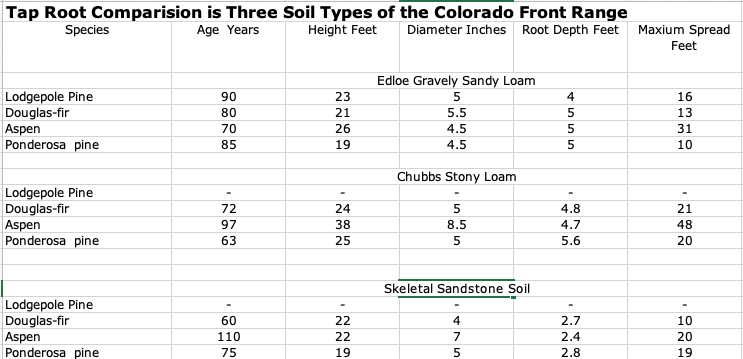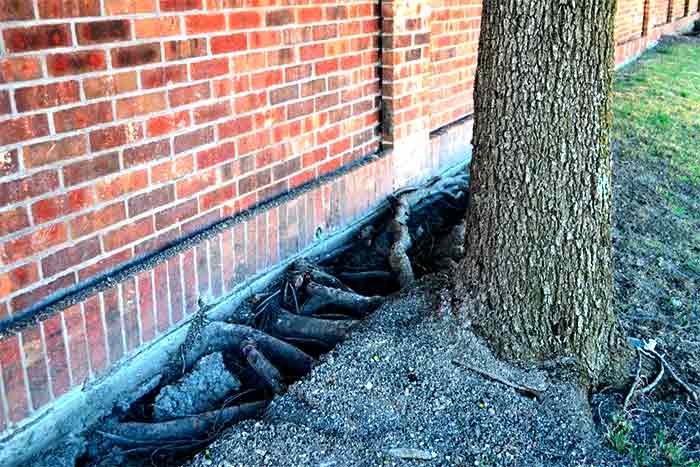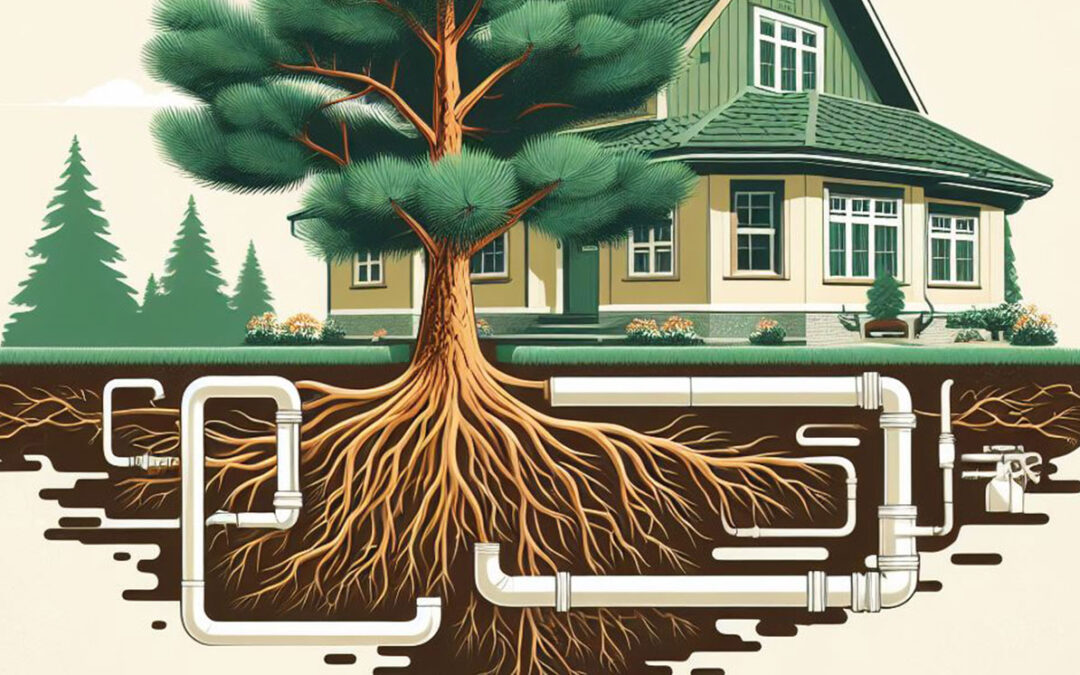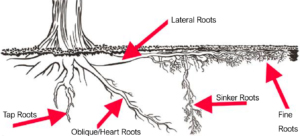Pine Tree Root Systems
Pine tree root systems keep trunks and canopies upright against wind and gravity forces. Anchorage resilience depends on various factors, including tree species, root health, soil composition, moisture levels, and root plate width. The “root plate” is about three to six times the trunk’s diameter and contains primary structural roots. Pine trees use their roots to absorb water, minerals, and nutrients. Needles, through photosynthesis, transport sugars to the roots, which are then stored as starches. In conifers, water and nutrients move up the trunk in a spiral pattern, supplying branches along the way. Root damage turns branches and needles brown along the spiral the root supplied.
Pine Tree Root Types
Lateral or Oblique Roots
Lateral and oblique roots act as anchors and range from 3/8 to 12 inches in diameter. They store starches and sugars and transport water, nutrients, and other compounds absorbed by the root system and energy produced by the needles throughout the tree. The tap root starts as a seed radicle, the first part of a seedling to emerge after germination. Lateral and oblique roots grow outward, absorbing water and nutrients and anchoring trees. Some trees have sinker roots that grow downward from laterals to take advantage of water and nutrients deeper in the soil.

Screenshot
In 1958, the US Forest Service undertook a study by Herbert Berndt and Robert Gibbons about the root distribution for pines and other plants that grow within watersheds along the Front Range in Colorado. The scientists dug up trees in different soils and measured their root systems. Their finding are in the above table. The soils investigated are:
- Edloe Gravely Sandy Loam soils are found on mountain slopes. They are moderately deep, well-drained soils made up of granite, metamorphic rock, or granular igneous rock.
- Chubbs Stony Loam soils are on crests and hillside slopes. They consist of shallow, well-drained soils made up of sandstone and shale.
- Skeletal soils contain at least 35% rock fragments, gravel, cobbles, and other materials. They are prone to erosion and have low natural fertility.
Fine or Feeder Roots
These roots range from 1/128 to 3/8 inches in diameter, and their job is water and mineral nutrient absorption. Low soil oxygen levels, drought, or fluctuations in soil temperature quickly kill the roots, but healthy pines rapidly reproduce them. Trees use symbiotic fungi to extend the reach of their root system, aid in the mineralization of plant nutrients, increasing drought tolerance and disease resistance.
The Extent of the Pine Root System
A mature pine’s root system occupies a much wider area than its canopy. In sandy soils, roots also tend to be massed near the soil’s surface because these soils have low levels of mineral nutrients. Trees produce large concentrations of roots near the surface to capture nutrients released from decomposing needle litter. In loamy soils, high oxygen levels allow tree roots to grow deeper, seeking nutrients and moisture. Denver is known for its heavy clay soils, which grow grass well but not trees. To maintain access to oxygen, tap roots of mature pines grow at least five feet deep in porous soils but seldom more than three feet deep in heavy clay soils.
Soil Issues Affecting Pine Tree Roots
Healthy soils are full of pockets or pores. Air replaces the water as gravity drains and empties the pores. Tree roots need oxygen to grow and live using respiration. During respiration, roots combine oxygen and sugar to produce energy to grow and feed sections of the tree. Below are issues that affect pine tree root health.
Soil Compaction: Compaction lessens the number of pores in the soil that hold oxygen, adversely affecting root and tree health. Compaction also makes it physically harder for roots to push through the soil, slowing growth.
Overwatering Soils: Perpetually wet soils fill pores with water, reducing the oxygen level needed for root respiration. Wet soils also slow the rate of oxygen diffusion between the atmosphere and the ground.
Improper Mulching: Applying too much mulch slows the diffusion of atmospheric gases into the soil. To avoid this problem, do not apply more than four inches of organic mulch around the base of trees.
Common Pine Tree Root Issues
Root Girdling: Pine trees are susceptible to girdling roots, which are circular roots that grow around a tree’s trunk, restricting the flow of water and nutrients. If not corrected, these roots cause trees to lose vigor and eventually die. The most common cause of root girdling is planting trees too deep or mulching over the root ball or flare. Homeowners should hire arborists to cut back girdling roots to a point where they will grow outward from the trunk. In-grown roots attached to the trunk should be left to avoid damaging the tree.
Surface Roots: Surface roots develop partially above the soil surface, becoming a tripping hazard and making mowing difficult. They develop when trees try to avoid low soil oxygen levels caused by compaction or overwatering. Homeowners can mulch around the roots to reduce tripping hazards.
Suckering: Roots produce shoots known as suckers from latent buds along a tree’s root system or trunk. Damage to roots encourages suckering. Their appearance at the base of trunks could be a sign of tree decline.
Pine Root Damage to Homes and Yards

Pine tree roots can extend outwards as far as two to three times the tree’s height. When planted too close to these structures, roots can damage sidewalks, driveways, fences, and building foundations. Correct pine sapling placement is the best way to avoid pine root damage. When deciding on a planting location, calculate the distance from the structure based on tree size and the reach of the pine tree root system. Proper watering and fertilizing encourage deeper root growth, and the trees rely less on surface roots, which can cause property damage.
- Lifted Sidewalks Or Driveways
Pressure can break concrete sidewalks and driveways as roots grow thicker or elongate.
- Cracks In Foundations
Large pines growing next to building foundations intrude into the concrete, causing uneven floors and stuck windows/doors. However, these issues can also be caused by soil settling and movement. Homeowners should call a foundation specialist for a professional diagnosis.
- Clogged Sewer Lines
Pine tree roots can infiltrate older clay and concrete residential sewer mains, causing damage, blockages, and backups.
Pine Tree Root Pruning
Root pruning is a horticultural practice that involves cutting back the roots of a tree to manage its growth. The best time to prune the roots of a pine tree is during its dormant season before new growth starts, which minimizes tree stress. Water the pine tree well a few days before pruning to reduce stress and make the roots more pliable. Use an air spade to evacuate the soil around the roots to be trimmed. Cut the roots cleanly using sharp tools to minimize damage and disease risk. Avoid tearing or crushing any roots. After pruning, backfill the soil around the tree, then mulch around the base to retain moisture and regulate temperature. Root pruning can reduce root damage, but best done by experts.
Got pine tree roots problems? Please click here to fill out a request service form or call 303-871-9121. We are at your service.


